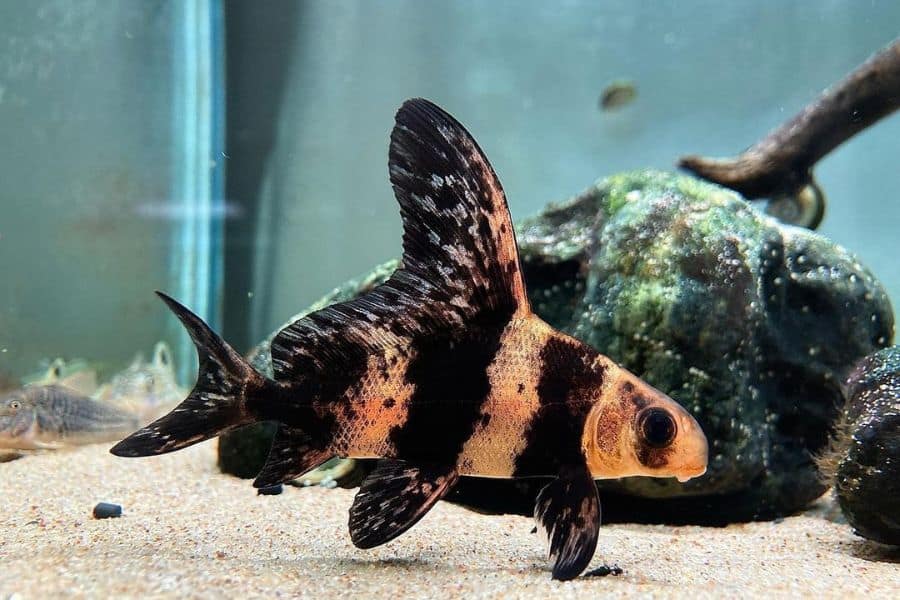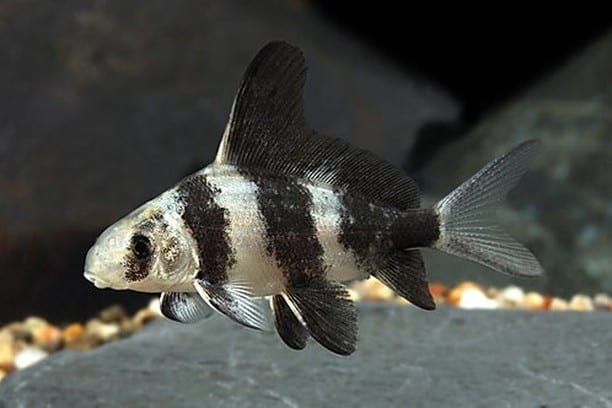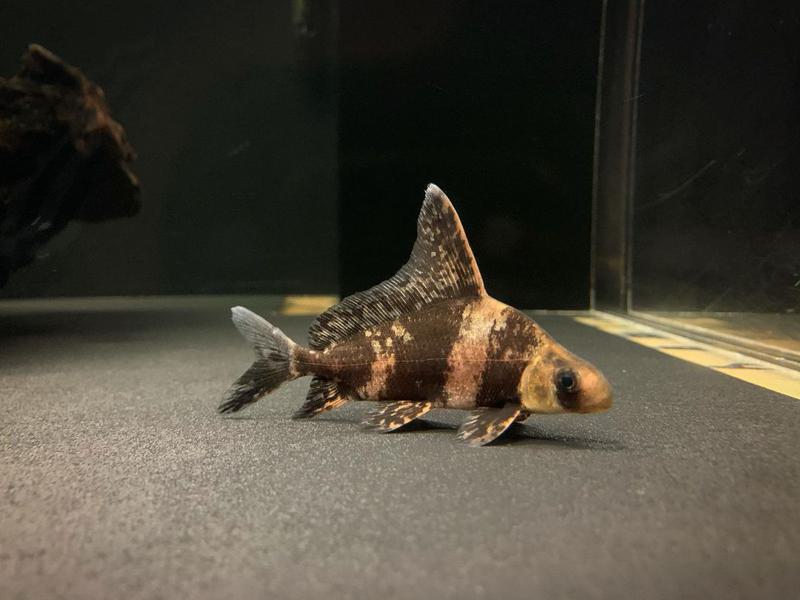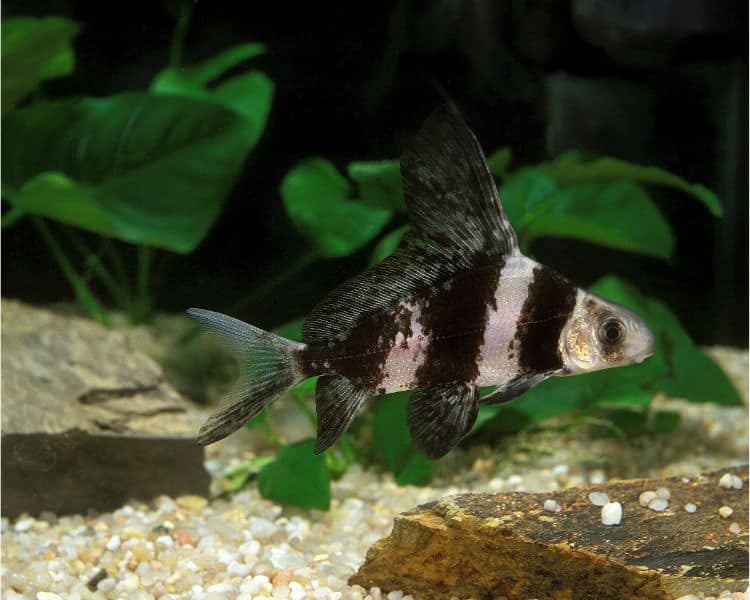Even though the Chinese High Fin Banded shark isn’t a real shark, it is still a bad aquarium pet for most enthusiasts. These gorgeously skinned fishes are best suited in ponds due to their enormous sizes that can span over 4 feet long.
It also does not help that they grow at a stupendous rate, from less than 2 inches long as juveniles to 24 inches tall upon maturity. There are very few regular-sized aquariums capable of housing such a big fish, let alone two or three, which is the recommended schooling group.

However, if you have a massive aquarium or are willing to care for the Chinese high-fin banded shark in a pond, then this article is for you.
Read on to learn all about the species and its origins. Get to learn of the best way to care for them and how to ensure they successfully breed.
Chinese High Fin Shark Overview
| Names | Chinese High Fin Banded Shark/ Chinese hi-fin banded shark
Also known as Topsail Sucker, Asian sucker, Chinese banded shark, high-fin banded loach, high-fin loach, or the Chinese Sailfin Sucker |
| Scientific Name | Myxocyprinus asiaticus |
| Origins | Originated from the Yangtze River basin, and other parts of China. |
| Tank Size | 55 gallons minimum for juveniles
300 gallons minimum for an adult fish |
| Water Hardness Conditions | 4 – 19 dGH |
| Ideal Tank Mates | Similar, peaceful, semi-aggressive, equal sized fish. |
| Average Size | Up to 4 feet 5 inches, typically 3 feet |
| Lifespan | Typically, up to 15 years, but can live up to 25 years in the ideal environment (wild habitat) |
| Lighting Conditions | Low light for up to 12 hours, with plenty of shade |
| Diet | Omnivorous |
| Optimal pH levels | 6.5 – 7.5 |
| Optimal Temperature | 55 – 78 degrees Fahrenheit |
The Chinese High Fin Banded Shark (Myxocyprinus asiaticus) is a freshwater fish species that is native to China, specifically the Yangtze River basin. It is also found in other rivers and lakes in China, including the Pearl River, the Min River, and Lake Dianchi.
The species has also been introduced to other regions around the world, including the United States, where it is often kept in aquariums. However, it is important to note that the species has the potential to become invasive in some areas and may pose a threat to native fish populations.
Chinese High Fin Banded Sharks are peaceful and semi-aggressive fish. In their natural habitat, they feed on invertebrates and small fish.
They are not true sharks, but rather a type of catfish. The shark in the name is a misnomer since the Chinese High Fin Banded Shark is not a true shark but rather belongs to the Catostomidae family of sucker fish with 70 plus other species including the smallmouth buffalo, black buffalo, spotted sucker, silver redhorse, golden redhorse, greater redhorse, white sucker, blue sucker, and the quillback.
Other common names used to identify the Chinese High Fin Banded Shark in the aquarium trade include: Topsail Sucker, Asian sucker, Chinese banded shark, high-fin banded loach, high-fin loach, the Chinese Sailfin Sucker, Chinese high-fin sucker, banded loach, Wimple, Wimple carp, Rough fish Chinese emperor, Freshwater batfish, Siamese sucker, Entsuyui, Chinese/Asian zebra high-fin sucker.
The endangered species is a major food source in the food industry around China. It is also used for medicinal purposes. Both of these reasons make it a very high target which is why it is part of China’s state protected species.
You might find it hard to source one if you are looking for high din shark for sale anywhere in the world. A typical 3-inch long juvenile costs about $24 – $99 in several pet stores.
Chinese High Fin Shark Appearances: Colors, Shapes, & Features

The Chinese high-fin banded loach has a striking coloration. Its body is generally a pale yellowish-brown or olive-brown color, with a series of bold, dark brown or black vertical bands that run along the sides of the body. These bands are usually wider towards the dorsal fin and narrower towards the ventral fin.
The fins of the Chinese high-fin banded shark are generally brownish or black, with the exception of the dorsal fin, which is tall and has a bright reddish-orange coloration. The dorsal fin is the most distinctive feature of this species and is used to attract mates during breeding season.
Suckers like the Chinese hi-fin shark possess a unique mouth structure that enables them to draw in invertebrates from the water body’s bottom. In addition to their lips, sucker fish have specialized teeth that are designed for scraping and grinding food. These teeth are arranged in a series of pads or ridges in the back of their mouths.
Chinese hi-fin fish also have a unique organ called a pharyngeal mill, which is located in their throat. This organ is lined with rows of small, bony plates that work together to grind up food as it passes through the digestive tract.
Like many other species, their colors change with their moods, and as they get older, the males’ and females’ colors start to shift drastically. This is because of the elongation of the body, causing the bands to disappear as the dorsal fin goes away too.
Sexually mature males have a strong reddish coloration, while female sharks have intense purple-like coloration with a vertical red patch along the body.
Lifespan
The Myxocyprinus asiaticus has a relatively long lifespan living on average up to 15 years. The species can also live up to 25 years in the wild with proper care.
However, their lifespan can be significantly reduced (up to 9 – 10 years of age) if they are kept in poor water conditions, inadequate diet, or overcrowded tanks.
It is important to provide them with a spacious aquarium with plenty of hiding places, a balanced diet, and regular water changes to ensure they live a healthy and happy life. Providing them with appropriate tank mates can also contribute to their longevity.
Average Size
On average, they can reach a length of up to 3 – 4 feet in captivity, although some have been known to reach up to 4.6 feet in the wild. It is essential to provide them with ample space to swim and grow in their aquarium to ensure their well-being.
Behavior & Temperament of The Chinese High Fin Shark
Chinese High Fin Banded Sharks are peaceful and do well in community aquariums with other non-aggressive fish. They are active swimmers and need plenty of open space to move around. It is important to note that these fish can become stressed in bright light, so it is recommended to have some areas of the tank that are shaded.
They are also bottom dwellers, spending most of their time at the bottom of the tank, rooting around for food and exploring.
Despite being peaceful, Chinese High Fin Banded Sharks can become territorial, especially during feeding time. It is important to provide plenty of hiding places and space for each fish to establish its own territory.
It is a good practice to keep the fish in groups of two or three since hi-fin sharks are social creatures. They do best when kept in groups, and care should be taken to ensure that the tank is large enough to accommodate the group.
Chinese High-Fin Banded Sharks Care

It is best if you keep the Chinese hi-fin banded sharks in a pond rather than a normal aquarium tank. Many enthusiasts buy the fish hoping that they will maintain their cuteness from their juvenile stages into their adult ages. However, they are surprised when the fish dies early, never reaches its 5 – 6-year sexual maturity, or fails to reproduce in captivity.
The truth is that it’s hard to properly care for such a big & unique fish in regular aquariums. Not only because of its massive size but also the rapid growth spurts the fish undergoes when it matures from a juvenile.
After all the above considerations, if you still find it fit to keep a Banded shark in your tank, then below are the best way to care for it:
Tank Size & Setup
The best tank size for an adult Chinese High Fin banded shark is a backyard pond with more than 1000 gallons of water. For an aquarium setup, a tank capable of holding at least 300 gallons is suitable, and that is for one Chinese banded shark.
However, the banded sharks thrive in groups of two or three. With that in mind, you may want to consider tanks at least 500 gallons in capacity.
The tank should also have good filtration to maintain water quality. These fish are sensitive to high levels of ammonia, nitrite, and nitrate, so regular water changes are necessary.
In the aquarium, they require a well-established ecosystem with plenty of plants and natural filtration. Providing a diverse ecosystem will help keep your fish healthy and happy.
Juvenile Chinese banded sharks can survive in 55-gallon tanks till maturity; watch out for the growth spurt.
Water Quality, Parameters, & Conditions
These fish are native to Asia and prefer a habitat with slow-moving or still water. They also require plenty of hiding places, such as caves, rocks, and driftwood. It is important to recreate their natural environment as closely as possible in your aquarium.
The Chinese High Fin Banded Sharks are also sensitive to bright lights, so make sure to provide plenty of shade and subdued lighting.
Like any other aquatic life, monitoring ammonia and nitrite levels in the tank is important to ensure they remain safe. Regular water changes are also essential for maintaining good water quality.
Recommended parameters:
- pH Levels: 5 – 7.5
- Water Temperature: 55 – 78 degrees Fahrenheit
- Water hardness: 4 – 19 dGH
- Ammonia, nitrite levels: 0 PPM
Chinese High Fin Diet
Hi-fins are omnivores, and their diet should consist of a variety of foods, including pellets, flakes, frozen foods, and live foods like worms and shrimp.
Some of the best foods for the Banded Sharks include:
- Brine shrimp
- Earthworms
- Frozen bloodworms
- Tubifex worms
- Mollusks
- Crickets
- Zucchini, spinach, and seaweed for vegetable diets
Compatible Tank Mates

When selecting tank mates for your Chinese High Fin Banded Sharks, it is important to consider their size, temperament, and compatibility with the same water parameters.
A lot of aquarists wonder if Chinese high-fin sharks can live with goldfish, and the answer is yes. These, as well as koi fish and loaches, are just some of the few compatible, non-aggressive fish that the peaceful Banded Sharks can get along with.
Other examples include:
- Bala Shark
- Dojo Loach
- Silver Dollar
- Rainbow Shark
- Clown Loach
- Hillstream loaches
- Pearl Gourami
- Red-tailed Shark
- Bronze Corydoras
- Neon Tetra
Make sure to research the specific needs and temperament of any potential tank mates before introducing them to the same aquarium.
How to Breed Chinese High-Fin Sharks
The short answer is you cannot breed the Chinese high-fin shark in captivity. In China, where they are plenty, the fish are let to migrate into the wild during the spawning season so that they can breed in their natural habitat surrounded by shallow waters that are fast flowing.
The specific conditions needed to breed such a kind cannot be easily simulated in an aquarium setup. A few successful cases have been done in ponds, and they usually induce hormonal treatments to ‘aid’ the fish into breeding with its kind.
Despite the attempts, there are no documented aquarists who have had success in breeding the Banded Sharks. It is advisable not to stress the fish in an attempt to do so since this will affect the health of the fish by compromising its immune system.
Read More:
- Aquarium Catfish Types
- Freshwater Aquarium Shark Fish Types
- Roseline Sharks: Care, Diet & Tank Mates
- Rainbow Shark Care
- Chinese Algae Eater Care
Conclusion
The Chinese High Fin Banded Shark is a unique and fascinating freshwater fish species that require a lot of space and care to thrive.
They are not suited for most aquariums due to their large size, and their rapid growth rate also poses a challenge. If you are in doubt about getting one, then it is best you look for other similar fish and stay clear of the Banded Shark.
However, if you have a large aquarium or pond and are willing to provide them with the appropriate living conditions, they can make great pets. It is essential to provide them with a spacious tank, a balanced diet, and regular water changes to ensure their well-being.
